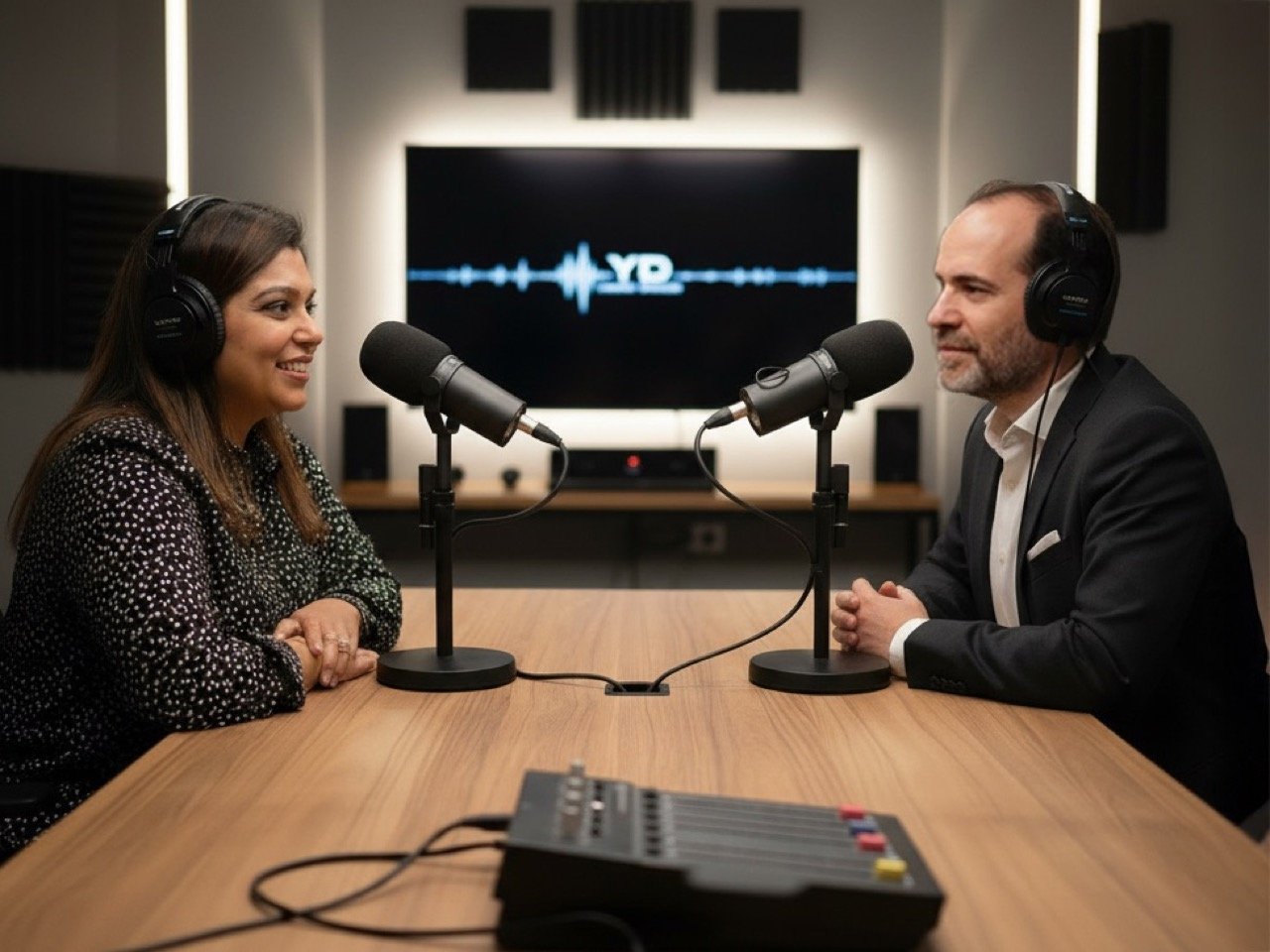A new chapter is beginning at Yanko Design, and it comes with a fresh voice. Every Friday, the Design Mindset podcast invites listeners into a world where design isn’t just about making things look good—it’s about grappling with the profound shifts technology brings to our daily lives. Hosted by Radhika Seth, the show peels back the layers of not just how designers work, but how they think, feel, adapt, and influence the world around them. From the tools we use in our kitchens to the digital interfaces that shape our routines, Design Mindset is about the messy, beautiful cross-section where human intention meets technological possibility.
For the premiere episode, the spotlight falls on Simon Bradford, VP Head of Digital Design at Electrolux Group. Bradford isn’t just a figurehead; he’s a veteran who’s spent over a decade watching humble kitchen appliances morph into smart, almost sentient devices. More than that, he’s a believer in the power of empathy to guide innovation, even as AI upends the old rules. If you want to understand where the future of design is heading—and what’s at stake when algorithms start making decisions that used to require a human heart—this conversation is essential listening.
Why Empathy and User-Centricity Still Matter in a World Full of AI
It’s easy to get swept up in the tide of AI hype, especially when tools promise to automate away the grunt work and leave us free to “be creative.” But the risk, as surfaced in this episode, is subtle and dangerous: designing for efficiency alone can strip products of their soul. The conversation opens with a warning that feels especially timely: efficiency isn’t the same as meaning. The allure of “light machines” that do everything quickly and predictably is strong, but what happens when those machines forget to ask why users feel the way they do?
Bradford’s perspective is nuanced. He doesn’t reject AI or fear it—he sees its arrival as an accelerant for new forms of creativity. The real challenge, he argues, is not in resisting the tide, but in steering it so that human empathy remains central. This isn’t just philosophical hand-wringing; it’s a call to action for designers everywhere. In a world where AI can generate a logo in seconds and predict your next move, the differentiator isn’t technical wizardry, but the ability to create products that people care about on a visceral level. That’s not something an algorithm can fake.
From Hardware to Heartware: Electrolux’s Digital Journey
It’s not every day you hear a 100-year-old company admit that its next century will require a total rethink. For Electrolux, the past was about building trustworthy physical products—refrigerators, dishwashers, ovens. But Bradford’s mission is to shepherd the brand through a metamorphosis, one where digital experiences and emotional resonance become as important as stainless steel finishes or energy ratings.
This digital transformation isn’t merely about slapping a screen onto an appliance. It’s about shifting the conversation away from technology for technology’s sake and towards the value those technologies bring to users’ lives. Digitalization, Bradford points out, has already upended business models across industries. For Electrolux, the real competitive edge comes from designing experiences that are not just easy to use, but deeply engaging—even if the hardware itself never changes. The company’s Scandinavian roots, with their focus on quality of life and user-centricity, turn out to be a secret weapon in this new era.
Designing Experience Flows, Not Just Products
When was the last time you thought of your oven as a companion instead of an appliance? That’s the kind of mental shift happening inside Electrolux’s design teams. Bradford describes their work not as building products, but as orchestrating “experience flows”—the invisible choreography between user and machine. It’s a subtle distinction, but one that signals a new way of thinking about design, where the end goal is an emotional connection rather than a checklist of features.
This approach means that technology is never the star of the show. Instead, it works in the background, enabling seamless, intuitive moments that people remember. Bradford and his team aren’t interested in talking about processors or sensors; they want to talk about how it feels to use something, how a product can fit effortlessly into your life, and how it can even surprise you with a touch of delight or comfort. The ultimate test? When users stop thinking about the tech altogether and start forming a bond with what it enables.
The Parallel Dance of AI and Human Touch
No one in the Electrolux design studio is naïve about AI’s capabilities. Research, prototyping, even early-stage ideation—AI can turbocharge these processes, delivering quick answers and surfacing ideas that might have taken weeks to uncover. But the team is careful not to let the pendulum swing too far. Synthetic testing and algorithmic predictions are run in tandem with old-school, hands-on methods: talking to real users, building physical prototypes, and spending time in people’s homes.
This parallel workflow is where the magic happens. AI delivers speed and breadth, but the human side of the process brings depth and context. It’s here that empathy comes into play. Bradford is clear: “An algorithm and data can come up statistically with that optimal design solution, but I think a designer will notice if it is applicable in the real world.” That final 20 percent—the part that transforms a product from functional to unforgettable—belongs to the humans. It’s the hardest part to get right, and the one AI is least equipped to handle.
When Intuition Beats Data: The Comfort Lift Story
If you want a proof point for the limitations of AI in design, look no further than Electrolux’s Comfort Lift dishwasher. This is not a triumph of machine learning or predictive analytics—it’s a story about human observation, intuition, and empathy. The idea was simple but revolutionary: lift the bottom rack of a dishwasher to make loading and unloading less of a strain. There was no precedent, no market data pointing at this pain point, but there was a designer who watched people struggle, made the connection to back pain, and decided to solve the problem.
The result? A product that didn’t just get the job done, but actually elicited joy—and even love—from users. Bradford tells the story of guests at a dinner party marveling at the Comfort Lift feature, one going so far as to say, “I really love this dishwasher.” That kind of emotional response is a designer’s holy grail, and it’s exactly the sort of leap that AI, for all its strengths, still can’t make. Sometimes, the most human innovations are the ones that machine logic would never dream up.
Building Emotional Connections: The Sticky Design Strategy
There’s a reason some objects feel like extensions of ourselves while others remain cold and anonymous. For Bradford, the ambition is to turn “an oven” into “my oven.” This isn’t just branding spin; it’s a deliberate strategy to make products sticky—objects you can’t bear to part with because they’re intuitive, responsive, and personal. It’s about more than just adding smart features. It’s about understanding what makes an experience effortless and rewarding at every touchpoint.
Metrics like low effort, intuitiveness, and relevant content become the yardsticks for success. But the real differentiator is emotional resonance. Bradford imagines ovens that remember your preferences, suggest recipes based on your lifestyle, and quietly fade away unused features so they never clutter your experience. The result is a product that feels bespoke, even if it’s mass-produced. If a person feels a positive bond with their appliance, you know you’ve crossed the invisible threshold from utility to affection.
What Designers Need to Thrive in the Next Decade
Change is the only constant in design, but the kind of change AI brings is different. Bradford points out that while previous technologies reshaped parts of the design workflow, AI is upending the entire process at once—and at breakneck speed. This means designers can no longer rely solely on technical skills; they need to cultivate curiosity, agility, and above all, adaptability. Those who thrive will be the ones who treat every project as a learning journey, eager to experiment and unafraid to question the status quo.
The future isn’t about resisting AI, but about marrying its capabilities with deep human insight. Designers must become comfortable interpreting AI-generated results, relentlessly testing assumptions in real-world contexts, and staying grounded in the needs and desires of actual users. The winners will be the ones who blend analytical intelligence with emotional smarts, always ready to pivot as technology evolves.
Universal Design and Emotional Complexity: Navigating Real-World Scenarios
One of the episode’s most compelling moments comes when the conversation turns to designing smart appliances for elderly users—a group often underserved by tech. The challenge: create something that offers AI-powered safety and convenience for anxious adult children, but preserves independence and comfort for the users themselves. Bradford’s answer is revealing. He doesn’t believe in age-segregated solutions. Instead, he champions the principle of universal design: if an experience is truly intuitive, it should work for everyone.
This philosophy draws on real-life anecdotes—a 92-year-old mother who sends emoji-laden texts on her phone, for example—to make the point that good design transcends demographics. The trick is to provide manual controls for those who want familiarity, while layering on advanced features for the curious. Safety features, both existing and imagined, are seamlessly integrated, but the process always starts with understanding the user’s perspective. No amount of data can replace the instinct to ask, “What makes you comfortable?”
Beyond the Hype: What AI Can and Can’t Do
AI’s strengths are obvious and undeniable: speed, efficiency, the ability to churn out alternatives in moments. But when it comes to nuance, context, and emotional intelligence, humans still hold the trump card. In a rapid-fire round, Bradford is quick to draw the line: “AI is brilliant at speed, efficiency, and coming up with lots of alternatives… Humans are irreplaceable for that human touch… empathy and knowing the context.” He’s also clear-eyed about the future: the emotional complexity of love, for example, remains well beyond AI’s grasp.
For up-and-coming designers, the message is both reassuring and energizing. There’s no need to worry about obsolescence; instead, the opportunity lies in embracing AI as a tool and using it to amplify what makes design uniquely human. The goal is not to compete with algorithms, but to use them as a springboard for deeper, more meaningful work.
The New Job of Designers: Translating Human Complexity
If there’s a single big idea that emerges from this conversation, it’s that the role of the designer is changing fundamentally. No longer just makers of objects, designers are now translators—interpreting the messy, beautiful complexity of human life into systems and experiences that feel natural, respectful, and empowering. The challenge isn’t whether AI will change the field; it already has. The real test is whether designers allow it to change how they think about people.
The final takeaway from the episode is as much a rallying cry as it is advice: don’t let the pursuit of efficiency blind you to the quirks and contradictions that make us human. If you want to build things that matter, embrace the messiness of the human mind, and never stop asking the questions that logarithms can’t imagine.
Design Mindset drops every Friday on Yanko Design. Tune in for conversations that challenge, inspire, and remind us all: don’t just live by default. Design it.
The post “Not Designing Products, We’re Designing Relationships”: Inside Electrolux’s Human-Centric AI Revolution first appeared on Yanko Design.

